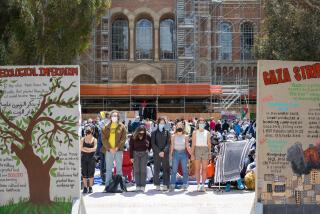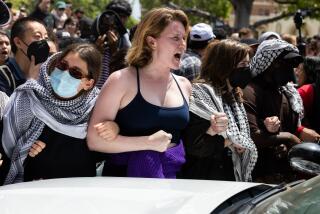An L.A. antiwar protest whose reverberations were felt nationwide
- Share via
“On the night of June 23, 1967, the meaning of ‘police brutality’ took on an electrifying reality for thousands of respectable middle-class residents of Los Angeles who participated in a peaceful anti-Vietnam demonstration that was to have taken them the few blocks from Cheviot Hills Park past the Century Plaza Hotel, where President Johnson was addressing a $1,000-a-couple Democratic fundraiser. Most never made it.” – From an account of the march written a few days later by my father, Richard Abcarian, a San Fernando Valley State College professor who’d brought his family to Century City that night.
Forty-six years ago today, Los Angeles was rocked by a violent police response to a peaceful demonstration against the Vietnam War. I don’t know if it’s taught in schools, or if anyone besides the people who were there remember it.
But it was an important moment in the life of the city, and its reverberations were felt across the rest of the country.
The day began on an upbeat note. The country’s foremost baby doctor, Benjamin Spock, and its most famous conscientious objector, Muhammad Ali, gave antiwar speeches in the park. In the evening, an unexpectedly large crowd of about 15,000 began marching north on Motor Avenue, turned right on Pico, then left on Avenue of the Stars toward the big, curved hotel.
The city permit called for marchers to keep moving — past the hotel, to Santa Monica Boulevard and back toward the park. But when the marchers approached the hotel, a group of demonstrators sat down in the street, stopping forward movement. Primed for a confrontation, and determined not to be embarrassed in front of the president and his supporters, who dined on filet mignon forestiere as the Supremes entertained, the police ordered the crowd to disperse.
The people who had sat down in protest stayed put. Few of the thousands of marchers behind them heard the dispersal orders; even if they had, they were trapped by the crowds and had trouble moving.
Watching from the comfort of a high floor in the hotel, Los Angeles Police Chief Tom Reddin ordered his men to break up the demonstration by force. Later, he claimed that communists and other radicals in the march had plotted to endanger the president by rushing the hotel.
“Pure fantasy,” scoffed one demonstrator, a college professor who had worked for the CIA for nearly a decade. He was one of many participants interviewed, and given anonymity, by the Los Angeles Times for a post-mortem that ran 10 days later.
On Friday, I looked up one of the organizers. Irving Sarnoff, now 83, lives in Pasadena and hasn’t given up the good fight. These days, his cause is the United Nations. In 1967, he was a co-chairman of the Peace Action Council, which sponsored the Century City march.
“There were communists, but there were socialists, hippies, Quakers, Methodists, all kinds of people,” said Sarnoff. “It was strange that they would attack a group of mainly middle-class people protesting the Vietnam War, who were marching under a permit granted by the city of Los Angeles.”
Another demonstrator, who described herself to The Times as a “middle-aged WASP, college graduate, PTA member, mother of four,” told the newspaper: “I was surprised there were not more young people, but most around us were respectable grown-ups self-consciously carrying signs, with apologetic smiles of people who felt, like me, that we were doing our duty in a way that was new for us.”
My father, for his part, did not know why the march had stopped, but sensed that something had gone wrong. That was confirmed when he saw about 40 officers in riot gear advance on us. We were forced onto an embankment where Olympic Boulevard crossed under Avenue of the Stars. Things took an awful turn:
“Directly in front of us, a lone young man in a red shirt was sitting in the street, directly in the line of approaching policemen, an obvious act of civil disobedience,” he wrote. “But it could not have been planned since no one had planned our retreat. In a moment of terrific empathy, I knew that what had led that young man to sit in the street was the obscene sight of the white helmeted phalanx moving in battle array against a peaceful, good natured crowd.
“You could feel the tension mount in the crowd with every step the police took. My 8-year-old daughter dissolved into sobs, so I swept her into my arms while I comforted my 11-year-old, who was beginning to weep. They pled with me to take them away.
“The slow, inexorable drama was shattered when one of the policemen began running for the young man, nightstick drawn. When he reached the young man, the rhythm of his running legs seemed to move into his night stick arm in a smooth uninterrupted action. He pounded the young man’s head and shoulders violently. For an adult it was sickening; my daughters were hysterical.
“A number of policemen had stationed themselves from the top to the bottom of the embankment and were ordering us to leave. As we passed a few feet away from one officer, he repeated the order. My 11-year-old daughter, normally restrained and shy of authority, turned on him in hysterical anger and shouted, ‘Shut up, you! You shut up!’ The officer’s face registered genuine human astonishment.”
I remember that night as a blur of terror and exhilaration, but mostly I remember a tremendous sense of relief that we finally got away from the riot police. I’d never seen anything so bloody and ugly. I’d certainly never screamed at a cop before, nor have I since.
But as much as the march proved a major moment in our family narrative, deepening our distrust of authority and cementing our opposition to the war, it left an important mark on the city, and the country.
Nearly two years earlier, the Watts riots had shaken to the core L.A.’s idea of itself and pulled the lid off the city’s endemic poverty, inequality and racial discrimination. Then, in 1967, the city’s privileged classes learned that their status offered nothing in the way of immunity from the blunt end of a police baton. It was the first time, The Times reported, that many people had seen white women beaten by police.
The protest also foreshadowed the country’s darkening mood on the war, and the huge antiwar demonstrations of the next four years.
After Century City, President Johnson, who could not bear the chant, “Hey, hey, LBJ, how many kids have you killed today?” began limiting his appearances to military bases and American Legion halls. Less than a year later, he announced he would not seek reelection.
As my father noted presciently in his essay about the march, “Chief Reddin’s view that it is the job of the police to shield the president from unfriendly citizens will make the campaign of 1968 something to watch.”
Was he ever right.
More to Read
Sign up for Essential California
The most important California stories and recommendations in your inbox every morning.
You may occasionally receive promotional content from the Los Angeles Times.














